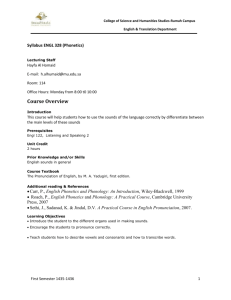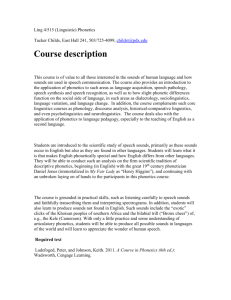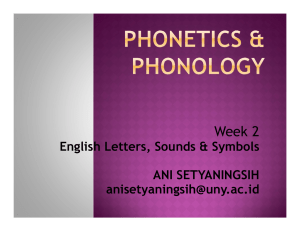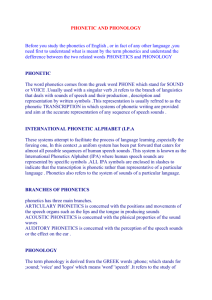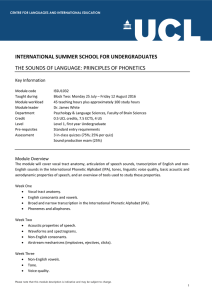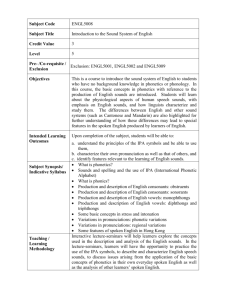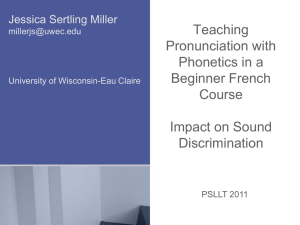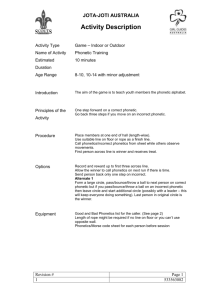SECL - University of Kent
advertisement
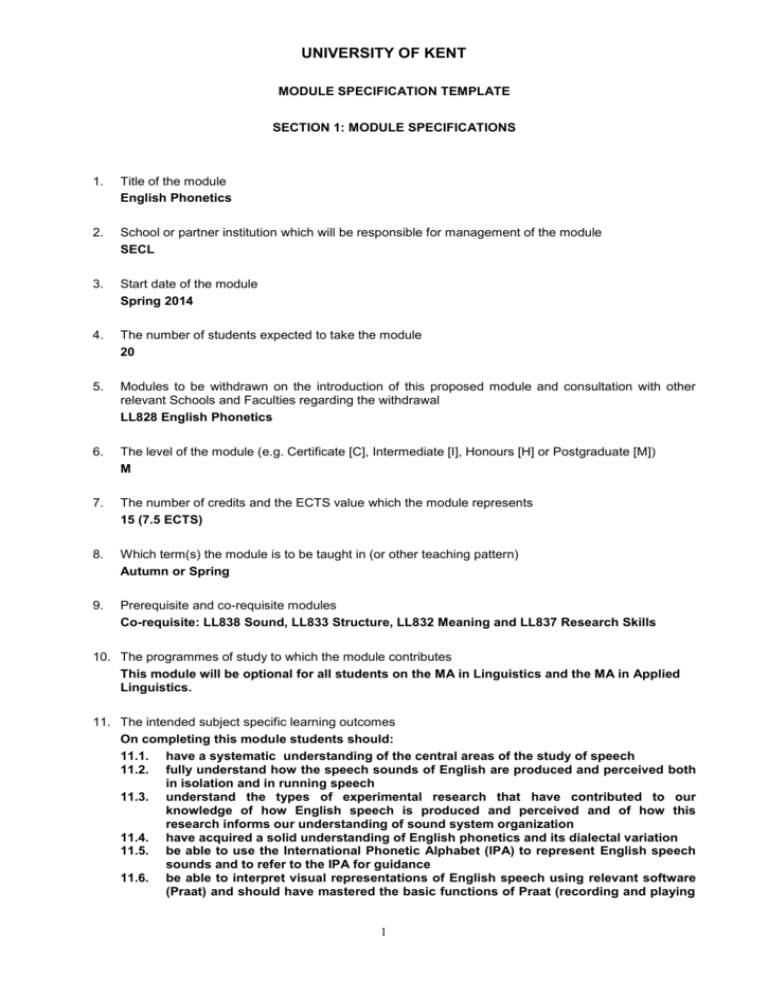
UNIVERSITY OF KENT MODULE SPECIFICATION TEMPLATE SECTION 1: MODULE SPECIFICATIONS 1. Title of the module English Phonetics 2. School or partner institution which will be responsible for management of the module SECL 3. Start date of the module Spring 2014 4. The number of students expected to take the module 20 5. Modules to be withdrawn on the introduction of this proposed module and consultation with other relevant Schools and Faculties regarding the withdrawal LL828 English Phonetics 6. The level of the module (e.g. Certificate [C], Intermediate [I], Honours [H] or Postgraduate [M]) M 7. The number of credits and the ECTS value which the module represents 15 (7.5 ECTS) 8. Which term(s) the module is to be taught in (or other teaching pattern) Autumn or Spring 9. Prerequisite and co-requisite modules Co-requisite: LL838 Sound, LL833 Structure, LL832 Meaning and LL837 Research Skills 10. The programmes of study to which the module contributes This module will be optional for all students on the MA in Linguistics and the MA in Applied Linguistics. 11. The intended subject specific learning outcomes On completing this module students should: 11.1. have a systematic understanding of the central areas of the study of speech 11.2. fully understand how the speech sounds of English are produced and perceived both in isolation and in running speech 11.3. understand the types of experimental research that have contributed to our knowledge of how English speech is produced and perceived and of how this research informs our understanding of sound system organization 11.4. have acquired a solid understanding of English phonetics and its dialectal variation 11.5. be able to use the International Phonetic Alphabet (IPA) to represent English speech sounds and to refer to the IPA for guidance 11.6. be able to interpret visual representations of English speech using relevant software (Praat) and should have mastered the basic functions of Praat (recording and playing 1 UNIVERSITY OF KENT 11.7. files, cutting and pasting speech, doing basic measurements of duration, amplitude and fundamental frequency of speech sounds) have an advanced understanding of English phonology 12. The intended generic learning outcomes On completing this module students should: 12.1. be able to critically assess different approaches to the study of speech and their repercussions for our understanding of how language is learned, stored and used by humans 12.2. demonstrate the ability to undertake independent learning in order to complete their assignments 12.3. communicate the results of their study accurately and coherently both orally and in writing 12.4. use IT skills to analyse data, take exams, and present information effectively 13. A synopsis of the curriculum This course is an introduction to English Phonetics. It covers how English speech sounds are produced and perceived and what their acoustic characteristics are; it covers how speech sounds are organized into the sound system of English and provides awareness of the types of dialectal variation present in English. Finally, the course will cover the differences between the traditional “static” view of speech sounds as articulatory postures and the organization of running speech, together with the repercussions that our current knowledge about running speech has for our understanding of phonological systems, their organization and formal representation. 14. Indicative Reading List 1. Ashby, M. & Maidment, J. (2005) Introducing Phonetic Science. Cambridge University Press. 2. Gussenhoven, C. & Jacobs, H. (1998) Understanding Phonology. Hodder & Arnold. 3. Ladefoged, P. & Johnson, K. (2011) A Course in Phonetics (6th edition). Wadsworth. 4. Ladefoged, P. (2003) Phonetic Data Analysis. Blackwell. 5. Ladefoged, P. (1996) Elements of Acoustic Phonetics. The University of Chicago Press 6. Reetz, H. & Jongman, A. 2009. Phonetics: Transcription, Production, Acoustics and Perception. Wiley-Blackwell. 7. Zsiga, E. C. 2013. The Sounds of Language: An Introduction to Phonetics and Phonology. Wiley-Blackwell. 15. Learning and Teaching Methods, including the nature and number of contact hours and the total study hours which will be expected of students, and how these relate to achievement of the intended learning outcomes This module will be taught in weekly 2 hour seminars for 10 weeks. Weeks 5 and 9 (if offered in the Autumn term) or 17 and 21 (if offered in the Spring term) will be used for independent study (learning outcome 12.1). The seminars will address key aspects of English phonetics and discuss them in light of basic phonological principles using appropriate examples (visual and auditory) and problems (learning outcomes 11.1-4&7 and 12.1). Practice in the use of the IPA alphabet and of freeware for recording and analysing speech will also be provided (learning outcomes 11.5-6, 12.1-4). Total Contact Hours: 20 Total number of study hours: 150 16. Assessment methods and how these relate to testing achievement of the intended learning outcomes 2 UNIVERSITY OF KENT 100% coursework, made up of: Seminar contribution (10%) Two tests (each equivalent to 1500 words) (20% each) Final project report (2000 words, 50%). Seminar contribution will be assessed on active participation in group discussions and individual contributions through questions, remarks, and comments, testing learning outcomes 11.1-7 and 12.1-3. Tests will include questions on articulation, acoustics and phonetic transcription as well as phonology problem sets, testing learning outcomes 11.1-7, 12.1-4. The final project will be determined for each student in consultation with the instructor and will test learning outcomes 11.1-7, 12.1-4. 17. Implications for learning resources, including staff, library, IT and space Staffing will be provided from the existing resources of the Department of English Language and Linguistics. The library holds most of the titles in the indicative reading list with others being on order, including multiple copies of all key texts. However, one additional element is essential: (i) a classroom with a computer projector, audio facilities and a whiteboard. 18. The School recognises and has embedded the expectations of current disability equality legislation, and supports students with a declared disability or special educational need in its teaching. Within this module we will make reasonable adjustments wherever necessary, including additional or substitute materials, teaching modes or assessment methods for students who have declared and discussed their learning support needs. Arrangements for students with declared disabilities will be made on an individual basis, in consultation with the University’s disability/dyslexia support service, and specialist support will be provided where needed. 19. Campus(es) where module will be delivered: Canterbury 3




